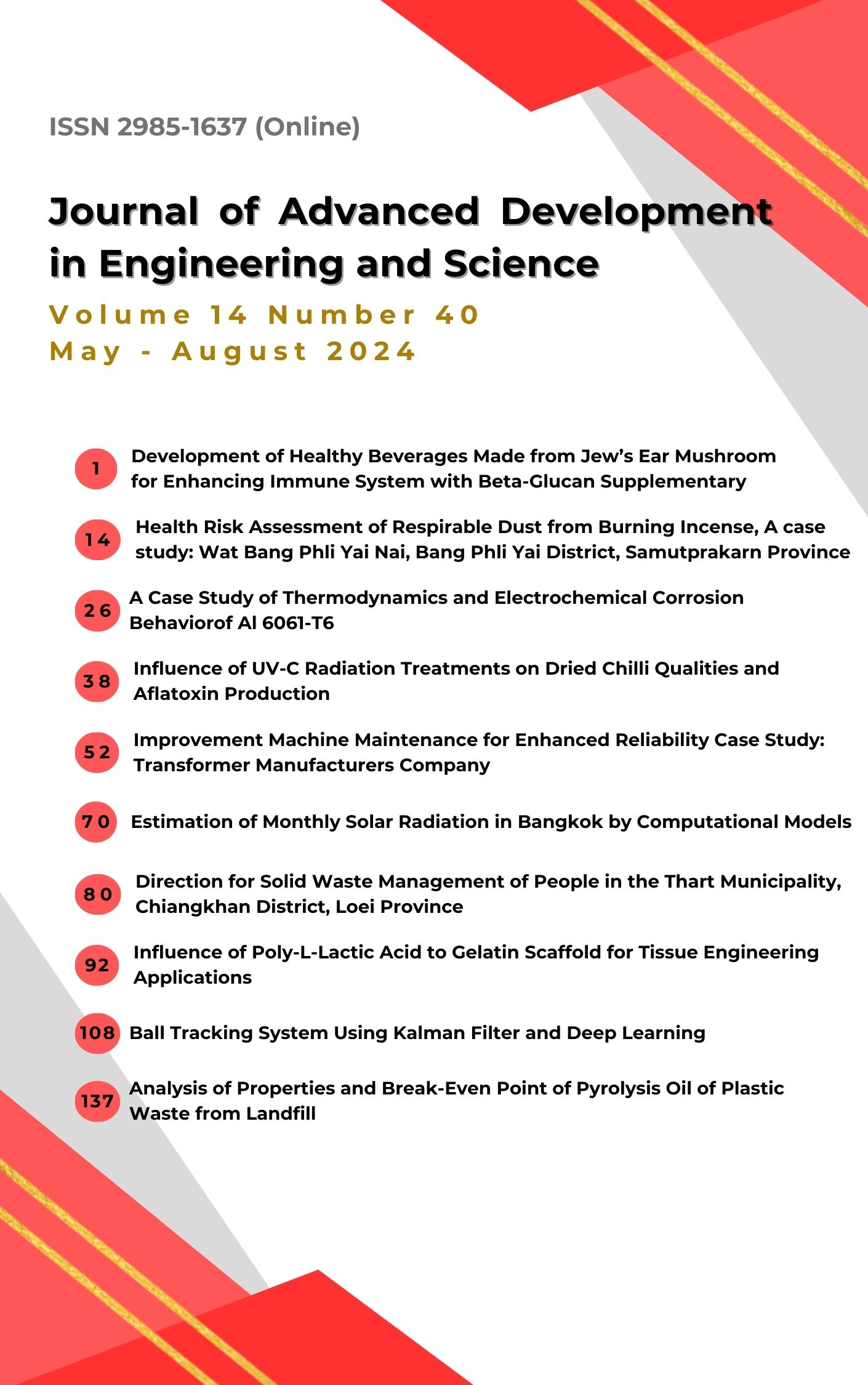Influence of Poly-L-Lactic Acid to Gelatin Scaffold for Tissue Engineering Applications
Main Article Content
Abstract
This research was aimed to investigate the influences of poly-L-lactic acid on gelatin scaffold. The gelatin scaffold was fabricated via freeze drying technique and blended with poly-L-lactic acid in different ratios. The surface structure of gelatin/poly-L-lactic acid scaffolds in different conditions was investigated by using Scanning Electron Microscopy (SEM). The poly-L-lactic acid blended on gelatin scaffold demonstrated the molecular structure of poly-L-lactic acid aggregated on gelatin scaffold with decreasing of mean pore size of scaffold structure when increasing of poly-L-lactic acid contentin some ratio. The results from swelling test revealed that increasing of poly-L-lactic acid content increased in swelling ratio of gelatin scaffold with significant different when compared with pure gelatin scaffold. These results proved that using poly-L-lactic acid blended with gelatin scaffold changed in morphology of gelatin scaffold and improved its physical properties of the gelatin scaffold with enhanced in swelling properties of gelatin scaffolds which could be applied using in tissue engineering applications.
Article Details

This work is licensed under a Creative Commons Attribution-NonCommercial-NoDerivatives 4.0 International License.
The content and information in articles published in the Journal of Advanced Development in Engineering and Science are the opinions and responsibility of the article's author. The journal editors do not need to agree or share any responsibility.
Articles, information, content, etc. that are published in the Journal of Advanced Development in Engineering and Science are copyrighted by the Journal of Advanced Development in Engineering and Science. If any person or organization wishes to publish all or any part of it or to do anything. Only prior written permission from the Journal of Advanced Development in Engineering and Science is required.
References
Mazaher, G., et al. (2018). 3D Protein-Based Bilayer Artificial Skin for the Guided Scarless Healing of Third-Degree Burn Wounds in Vivo. Biomacromolecules, 19(7), 2409-2422.
Shahriari-Khalaji, M., et al. (2023). Angiogenesis, Hemocompatibility and Bactericidal Effect of Bioactive Natural Polymer-Based Bilayer Adhesive Skin Substitute for Infected Burned Wound Healing. Bioactive Materials, 29, 177-195.
Gelse, K., et al. (2003). Collagens-Structure, Function, and Biosynthesis. Advanced Drug Delivery Reviews, 55, 1531-1546.
Mondschein, R. J., et al. (2017). Polymer Structure-Property Requirements for Stereo- lithographic 3D Printing of Soft Tissue Engineering Scaffolds. Biomaterials, 140, 170-188.
Hong, S. R., et al. (2001). Study on Gelatin-Containing Artificial Skin IV: A Comparative Study on the Effect of Antibiotic and EGF on Cell Proliferation During Epidermal Healing. Biomaterials, 22(20), 2777-2783.
Young, S., et al. (2005). Gelatin as a Delivery Vehicle for Thecontrolled Release of Bioactive Molecules. Journal of controlled Release, 109(1-3), 256-274.
Soleiman-Dehkordi, E., et al. (2024). Multilayer PVA/Gelatin Nanofibrous Scaffolds Incorporated with Tanacetum polycephalum Essential Oil and Amoxicillin for Skin Tissue Engineering Application. International Journal of Biological Macromolecules, 262(1), 129931.
Nasiri, G., et al. (2022). Fabrication and Evaluation of Poly(vinyl alcohol)/Gelatin Fibrous Scaffold Containing ZnO Nanoparticles for Skin Tissue Engineering Applications. Materials Today Communications, 33, 104476.
Hongxu, L., et al. (2012). PLLA–Collagen and PLLA–Gelatin Hybrid Scaffolds with Funnel-Like Porous Structure for Skin Tissue Engineering. Science and Technology of Advanced Materials, 13(6), 064210.
Aswathy, R.G., et al. (2020). Collagen-Functionalized Electrospun Smooth and Porous
Polymeric Scaffolds for the Development of Human Skin-Equivalent. RSC Advances 10, 26594–26603.
Ishaug-Riley, S. L., et al. (1999). Human Articular Chondrocyte Adhesion and Proliferation on Synthetic Biodegradable Polymer Films. Biomaterials, 20(23-24), 2245–2256.
Yang, F., et al. (2004). Fabricationof Nanostructured Porous PLLA Scaffold Intended for Nerve Tissue Engineering. Biomaterials, 25(10), 1891–1900.
Park, S. S., et al. (2004). Characteristics of Tissue-Engineered Cartilage from Human Auricular Chondrocytes. Biomaterials, 25(12), 2363–2369.
Ramasamy, M. S., et al. (2022). Combination of Polydopamine and Carbon Nanomaterials Coating Enhances the Piezoelectric Responses and Cytocompatibility of Biodegradable PLLA Nanofiber Scaffolds for Tissue Engineering Appications. Materials Today Communications, 33, 104659.
Duan, R., et al. (2022). The Effect of Blending Poly (L-lactic acid) on in vivo Performance of 3D-Printed Poly (L-lactic-co-caprolactone)/PLLA Scaffolds. Biomaterials Advances, 138, 212948.
Karageorgiou, V. & Kaplan, D. (2005). Porosity of 3D Biomaterial Scaffolds and Osteogenesis. Biomaterials, 26(27), 5474-5491.
Kang, H. W., et al. (1999). Fabrication of Porous Gelatin Scaffolds for Tissue Engineering.
Biomaterials, 20(14), 1339-1344.
Mao, J. S., et al. (2003). Structure and Properties of Bilayer Chitosan-Gelatin Scaffolds.
Biomaterials, 24(6), 1067-1074.
John, P. F., et al. (2007). Tissue Engineering. New York: CRC Press.
Wiwatwongwana, F. & Promma, N. (2019). Characterization of Gelatin-Carboxymethylcellulose Scaffolds. International Journal of Materials, Mechanics and Manufacturing, 7(1), 12-15.
Wiwatwongwana, F. & Surin, P. (2019). In Vitro Degradation of Gelatin/Carboxymethylcellulose Scaffolds for Skin Tissue Regeneration. Chemical Engineering Transactions, 74, 1555-1559.
Chaijit, S. & Wiwatwongwana, F. (2020). Strengthening Scaffold by Using Carbodiimide
Crosslinking on Gelatin/Carboxymethylcellulose from Waste Product. Chemical Engineering Transactions, 80, 331-336.

